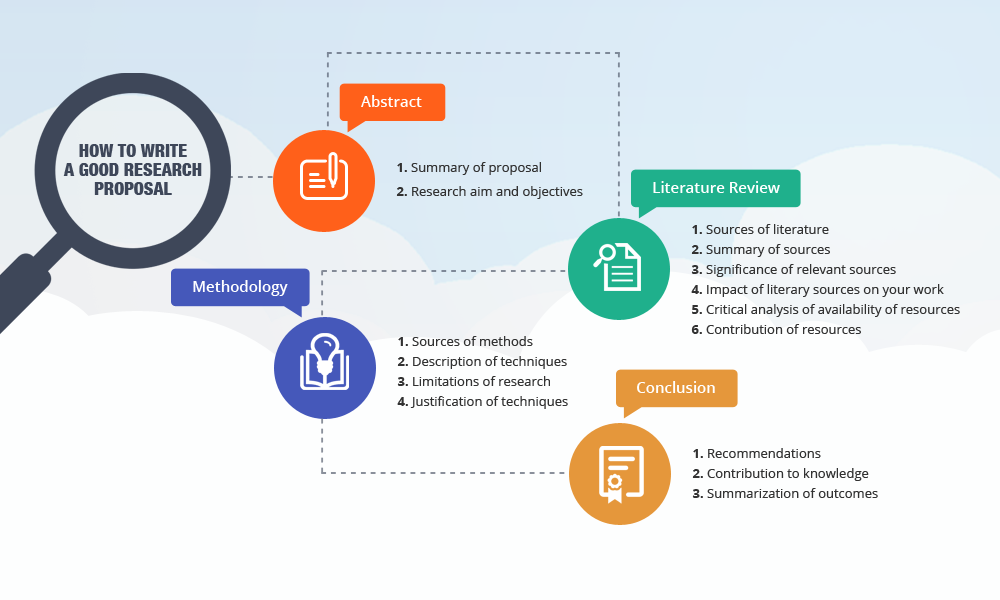--------------------------------------
Adapted from "Organizing Your Social Sciences Research Paper," USC Libraries, University of Southern California, <https://libguides.usc.edu/writingguide/researchproposal>, accessed 4 Feb.. 2022.

A research proposal is simply a structured, formal document that explains what you plan to research (i.e. your research topic), why it’s worth researching (i.e. your justification), and how you plan to investigate it (i.e. your practical approach).
The purpose of the research proposal (it’s job, so to speak) is to convince your research supervisor, committee or university that your research is suitable (for the requirements of the degree program) and manageable (given the time and resource constraints you will face).
The most important word here is “convince” – in other words, your research proposal needs to sell your research idea (to whoever is going to approve it). If it doesn’t convince them (of its suitability and manageability), you’ll need to revise and resubmit. This will cost you valuable time, which will either delay the start of your research or eat into its time allowance (which is bad news).
Research proposals generally follow the same format as a research paper, with an introduction, a literature review, a discussion of research methodology and goals, and a conclusion.
From: Wong, Paul T. P. How to Write a Research Proposal. International Network on Personal Meaning. Trinity Western University
The first part of your proposal is the initial pitch for your project, so make sure it succinctly explains what you want to do and why. It should:
Some important questions to guide your introduction include:
If your proposal is very long, you might include separate sections with more detailed information on the background and context, problem statement, aims and objectives, and importance of the research.
It’s important to show that you’re familiar with the most important research on your topic. A strong literature review convinces the reader that your project has a solid foundation in existing knowledge or theory. It also shows that you’re not simply repeating what other people have already done or said.
In this section, aim to demonstrate exactly how your project will contribute to conversations in the field.
The literature review serves several important functions:
Discussion
The purpose of the discussion is to interpret and describe the significance of your findings in light of what was already known about the research problem being investigated, and to explain any new understanding or fresh insights about the problem after you've taken the findings into consideration. The discussion will always connect to the introduction by way of the research questions or hypotheses you posed and the literature you reviewed, but it does not simply repeat or rearrange the introduction; the discussion should always explain how your study has moved the reader's understanding of the research problem forward from where you left them at the end of the introduction.
This section is often considered the most important part of a research paper because it most effectively demonstrates your ability as a researcher to think critically about an issue, to develop creative solutions to problems based on the findings, and to formulate a deeper, more profound understanding of the research problem you are studying.
The discussion section is where you explore the underlying meaning of your research, its possible implications in other areas of study, and the possible improvements that can be made in order to further develop the concerns of your research.
This is the section where you need to present the importance of your study and how it may be able to contribute to and/or fill existing gaps in the field. If appropriate, the discussion section is also where you state how the findings from your study revealed new gaps in the literature that had not been previously exposed or adequately described.
This part of the paper is not strictly governed by objective reporting of information but, rather, it is where you can engage in creative thinking about issues through evidence-based interpretation of findings. This is where you infuse your results with meaning.
Kretchmer, Paul. Fourteen Steps to Writing to Writing an Effective Discussion Section. San Francisco Edit, 2003-2008.
Conclusion
The conclusion is intended to help the reader understand why your research should matter to them after they have finished reading the paper. A conclusion is not merely a summary of your points or a re-statement of your research problem but a synthesis of key points. For most essays, one well-developed paragraph is sufficient for a conclusion, although in some cases, a two-or-three paragraph conclusion may be required.
A well-written conclusion provides you with several important opportunities to demonstrate your overall understanding of the research problem to the reader. These include:
Conclusions. The Writing Center. University of North Carolina; Kretchmer, Paul. Twelve Steps to Writing an Effective Conclusion. San Francisco Edit, 2003-2008.
